It wasn’t that long ago that accidentally saving over or deleting a file meant your work was probably gone.
If your organization performed nightly backups, you might be able to retrieve the previous day’s version. However, if there was no backup the previous day, or if you started it the same day, you had to recover it the hard way – by recreating it. This meant many hours of wasted productivity when you consider how many times it’s happened.
Collaborative, cloud-based tools like Microsoft Office 365 have changed the story by providing version history that has greatly reduced lost productivity (and user frustration). But there are so many other ways you can lose data: from accidental to malicious actions both internally and externally.
Data loss is defined as “any process or event that results in data being corrupted, deleted and/or made unreadable by a user and/or software or application.” We’re going to cover various ways data loss happens and how to recover from these incidents and minimize the impact on your business.
Types of malicious data loss
Malware, or malicious software, can be used to infiltrate individual computers or networks to gain access to information. However, unlike hacking, malware can be executed in a more passive manner to achieve the objective. Here are a few types of malware and how they impact the integrity of data in an organization.
Viruses – In the late 1990s, people got their first widespread exposure to malware with viruses, specifically the Melissa virus. Though viruses aren’t as common anymore, once triggered they can cause a lot of damage and be difficult to eliminate since attach to legitimate files and spread when the user opens the infected file.
Worms – Unlike viruses, worms are self-replicating and spread by exploiting vulnerabilities such as out-of-date operating systems (OS), bugs in a particular OS, or anti-virus software. Worms can be payload free and spread with the intent of bogging down a network. Or they can carry a payload such as a virus or ransomware.
Trojan horses – Disguised as legitimate files, Trojans can be activated by unsuspecting users and establish a way for third-parties to gain access or download other malware. While the initial action may affect only a single computer, the impact can easily spread depending on what the perpetrator aims to do. Trojans can be a delivery mechanism for viruses, ransomware and other types of malware.
Ransomware – In recent years, ransomware attacks have increased as people and organizations recognize the inherent value of data. Blocking an individual or organization from accessing sensitive or intellectual property data is good incentive for the ransom to be paid.
These are just a few ways external bad actors can use malware to affect your access to and use of valuable data in malicious ways.
Internal threats from bad actors
Disgruntled employees – both current and former – can put organizations at significant risk of data loss if they have access to files and choose to delete them. This can be particularly damaging when the employee has access to valuable or sensitive data and/or the organization isn’t in the habit of performing regular backups.
Types of accidental data loss
Almost every worker with a computer has inadvertently deleted or overwritten files at one time or another. As discussed above, this isn’t the problem it once was thanks to cloud-based collaboration tools like Office 365. However, data can also be lost due to natural disasters, hardware failures, and software errors.
There’s very little that can be done to ward off natural disasters or hardware/software failures, but it’s possible to recover from the data loss without entering crisis mode.
How to quickly recover from data loss
Recently, the band Radiohead revealed they had been hacked. The hackers stole 18 hours of recordings and demanded the band play a ransom or they would release the recordings to the public. Instead of paying the ransom, the band released the recordings for sale and proceeds are going to a cause they support.
This is a great story but it’s not a realistic approach for organizations dealing with bad actors or accidental data loss. Because data loss is inevitable at some point, whether it’s malicious or not. What makes a difference is the infrastructure and process that kicks in to facilitate recovery of the lost data.
The key to ensuring data loss doesn’t become a crisis situation is having a robust backup protocol and infrastructure that can provide continuous data protection for your organization’s most valuable asset. This gives peace of mind that – even with the malicious attempts of bad actors to disrupt your business – you can carry on with business as usual.


